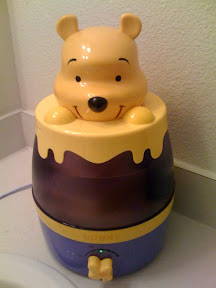Health | Technology > Humidifier Review
 Summary. On 12 February 2008, I discovered and purchased a Winnie The Pooh Dr. Fresh Disney Ultrasonic Humidifier. The following day, I purchased a second unit to attain a greater humidity output capacity per hour. With the colder weather in Iowa (as much as 30 below zero), forced air furnace heating systems dry out the air even faster, so more humidification is needed. I eventually took both units back to the store (on 20080223sa) for reasons explained below.
Summary. On 12 February 2008, I discovered and purchased a Winnie The Pooh Dr. Fresh Disney Ultrasonic Humidifier. The following day, I purchased a second unit to attain a greater humidity output capacity per hour. With the colder weather in Iowa (as much as 30 below zero), forced air furnace heating systems dry out the air even faster, so more humidification is needed. I eventually took both units back to the store (on 20080223sa) for reasons explained below.
Price. Our local Walgreens had these on sale for $29 rather than the $40 to $50 retail price they normally sell for. Some ultrasonic humidifiers sell for as much as $200, such as the Air-O-Swiss brand. So, this $29 system seemed like a good value.
Benefits and Special Features. Of the most common humidifier systems available today, ultrasonic is one of the best methods. In addition to the general benefits of ultrasonic humidifiers (quiet, clean, effective) the Winnie the Pooh model has a few unique features worth noting:
- Variable Output. Some ultrasonic humidifiers have two or three possible output settings. This is somewhat limiting. This Pooh Bear model has a variable control that permits full control over the output.
- Greater Distribution. Some units will send out a single stream of mist. This Pooh Bear model has mist coming out both ears which allows the moisture to be more widely distributed and therefore more readily absorbed into the ambient air.
- Night Light. It is becoming common to have night lights in humidifiers. The Winnie the Pooh model includes a switch to enable and disable the included night light. When on, the water reservoir lights up.
- Water Filter. It’s common for ultrasonic humidifiers not to have any filtration system. Because they are so effective at evaporating water, they can leave a dusty residue on surfaces. The Winnie the Pooh model has a filter for the water to eliminate this problem.
- Easy Assembly. The Pooh Bear cover is easily removed by lifting it off. Under it, the ring of honey is also easily removed by lifting off. Under the Pooh Bear head, any surface condensation of water is returned to the ultrasonic evaporative system. This ensures that only the finest vapors escape, and it contains the evaporative “wet surface water” inside the unit.
Proper Placement. For best use, humidifiers that produce visible steam or mist should be placed on a high surface. This allows for a sufficient distance to allow the steam or mist to become absorbed into the ambient air. Any cold surfaces will cause the steam or mist to condense quickly rather than being absorbed into the air. This will result in surface moisture rather than an increase in humidity.
Demineralization Filter Doesn’t Work. Although the humidifier comes with a filter that is designed to remove minerals and other impurities from the water, the filter doesn’t work very well. This results in a fine white powder being deposited on mirrors, metal, and other surfaces in the room where the humidifier is used.
Expensive to Use. Because the demineralization filter didn’t work, it would have been necessary to use distilled water to avoid mineral deposits.
Potential Pulmonary Respiratory Bronchial Hazard. Depending on the water used, most ultrasonic humidifiers produce a fine powdery layer of mineral deposits and other impurities on surfaces in the room where they are used. It is logical to assume this fine powder also makes it into a person’s lungs. Because lungs typically do not respond well to fine powdery substances, it is reasonable to conclude that ultrasonic humidifiers may be harmful to the human respiratory system. Mineral dust itself is not usually a hazard. If minerals are found in water, it is considered beneficial. If mineral dust is breathed into the lungs, it could be hazardous. [More]